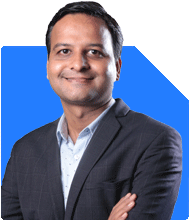Sir My age is 29. How much amount i have to invest in SIP for 5 Cr Corpus in 20 years.
Ans: your goal of building a Rs 5 crore corpus over 20 years through SIP investments is a significant and achievable target. Let's carefully explore the best way to approach this, considering your age and the power of long-term investments.
At 29, you have a considerable time horizon. This gives you a great advantage in compounding growth over time. A well-structured plan with disciplined SIP contributions can help you reach your financial goal comfortably.
Below is a comprehensive and 360-degree approach to achieving this target while keeping everything simple and straightforward.
The Power of Compounding Over 20 Years
The first key factor in building a large corpus is to understand the power of compounding. Over time, the returns on your investments will multiply, especially when invested in mutual funds. The longer you stay invested, the greater your returns, as they are compounded annually.
Even small contributions made consistently through SIP can grow into substantial amounts.
Three critical factors that affect how much you need to invest monthly are:
The rate of return you expect from your investments.
The time horizon, which in your case is 20 years.
The corpus target, which is Rs 5 crore.
Choosing the Right Type of Mutual Fund
For long-term goals like this, equity mutual funds are typically recommended. However, choosing actively managed funds instead of index or direct funds will be essential for maximizing your returns. Let’s briefly discuss why actively managed funds are better for long-term wealth creation.
Why Actively Managed Funds?
Actively managed funds offer the benefit of professional fund management. A seasoned fund manager makes investment decisions based on market research and economic conditions, aiming to outperform the market and provide better returns than passively managed funds like index funds.
Index funds only aim to replicate the performance of a benchmark index, which may limit returns.
Direct funds may reduce costs, but many investors prefer regular plans due to the professional advice they get through mutual fund distributors (MFDs), especially those with CFP credentials.
Rate of Return Expectations
For this calculation, let’s assume an expected return from equity mutual funds of around 12%. This is a realistic expectation for equity investments over the long term. Historically, equity markets have provided such returns over two decades or longer.
Keep in mind that actual returns can fluctuate year by year due to market volatility. However, sticking to the plan despite market ups and downs will allow you to benefit from long-term growth.
Monthly SIP Contribution
To accumulate Rs 5 crore over 20 years, a disciplined SIP approach is key. Since we expect a return of 12% over this period, the monthly SIP amount you will need to invest is crucial. Based on this, the SIP contribution required to reach Rs 5 crore could be estimated. I won’t go into specific calculations here, but you can adjust your contribution if the market returns are higher or lower.
Review and Adjustments Over Time
While your SIP contributions will be consistent, it is wise to review your investment every few years. The market, your personal financial situation, and your goals may evolve. If, at any point, you feel that the returns are not aligning with your expectations, consider rebalancing your portfolio. Actively managed funds allow flexibility and adjustments based on market conditions, which direct or index funds do not provide.
You may also want to increase your SIP amount over time as your income increases or as your expenses reduce. For example, every two to three years, consider increasing the SIP amount by 10% to 15%. This will help you reach your Rs 5 crore target faster and counter inflation.
Taxation on Mutual Funds
As you grow your investments, keep in mind the taxation rules on mutual fund investments.
Equity mutual funds: When you sell units after holding them for more than a year, gains over Rs 1.25 lakh are taxed as long-term capital gains (LTCG) at 12.5%.
Short-term capital gains (STCG): If units are sold within a year, the gains are taxed at 20%.
While tax should not be the primary focus, understanding it will help you plan better when it’s time to redeem or rebalance your investments.
Build an Emergency Fund First
Before you dive fully into SIPs, it is crucial to ensure that you have an emergency fund in place. The emergency fund should cover at least six to twelve months' worth of expenses. This will help you avoid withdrawing from your mutual fund investments in case of emergencies, allowing your corpus to grow uninterrupted.
Your emergency fund should ideally be kept in liquid or debt funds for easy access. These funds are relatively low-risk and provide moderate returns.
Protecting Your Investments
While focusing on building wealth, it’s equally important to protect it. Make sure you have adequate health and life insurance.
Life insurance: A term insurance plan is the best option for providing financial security to your dependents in case of any unfortunate event.
Health insurance: Ensure you have sufficient health coverage, separate from any corporate insurance plan. Medical emergencies can deplete your savings if not adequately insured.
Benefits of Regularly Investing Through MFD with CFP Credential
Investing through a mutual fund distributor (MFD) who is also a Certified Financial Planner (CFP) offers a lot of benefits. They can provide you with expert guidance, portfolio reviews, and help you stick to your long-term goals. An MFD with CFP credentials brings a holistic approach to financial planning and will help you navigate different market cycles and keep your financial plan on track.
Regular plan investments are ideal for getting professional advice.
Direct plan investments may seem cost-effective, but they do not offer the same level of service and guidance, which is critical for long-term success.
Avoid Real Estate Investments
While real estate might seem like an attractive option to many, it is better to avoid it for long-term wealth creation. Real estate investments come with high entry and exit costs, liquidity challenges, and legal complexities. Mutual funds provide better flexibility, liquidity, and returns over the long term, especially when your goal is Rs 5 crore in 20 years.
Inflation-Proof Your Future
The goal of Rs 5 crore should not just be viewed as a number but as a future financial requirement that can beat inflation. Over the next 20 years, inflation will erode the purchasing power of money. Therefore, it is essential to ensure that your investments grow at a rate that outpaces inflation, which is typically achieved through equity mutual funds.
Equity funds have consistently outperformed inflation over the long term. By maintaining a disciplined SIP approach and avoiding early withdrawals, your corpus can remain inflation-proof.
Final Insights
To summarize the plan:
Start your SIP in actively managed mutual funds with a goal to accumulate Rs 5 crore.
Invest through regular funds, preferably via an MFD with CFP credentials, for professional guidance.
Expect a return of around 12% from equity mutual funds over 20 years.
Review your SIP amount every few years and consider increasing it as your income grows.
Build an emergency fund first, covering six to twelve months of expenses.
Ensure you have adequate life and health insurance coverage to protect your wealth.
Refrain from investing in direct funds or real estate, as they may not offer the same benefits as actively managed mutual funds.
Stay disciplined with your investments and avoid emotional decisions driven by short-term market fluctuations.
By following this structured approach, you can stay on track to achieve your Rs 5 crore target in 20 years.
Best Regards,
K. Ramalingam, MBA, CFP,
Chief Financial Planner,
www.holisticinvestment.in
https://www.youtube.com/@HolisticInvestment



























